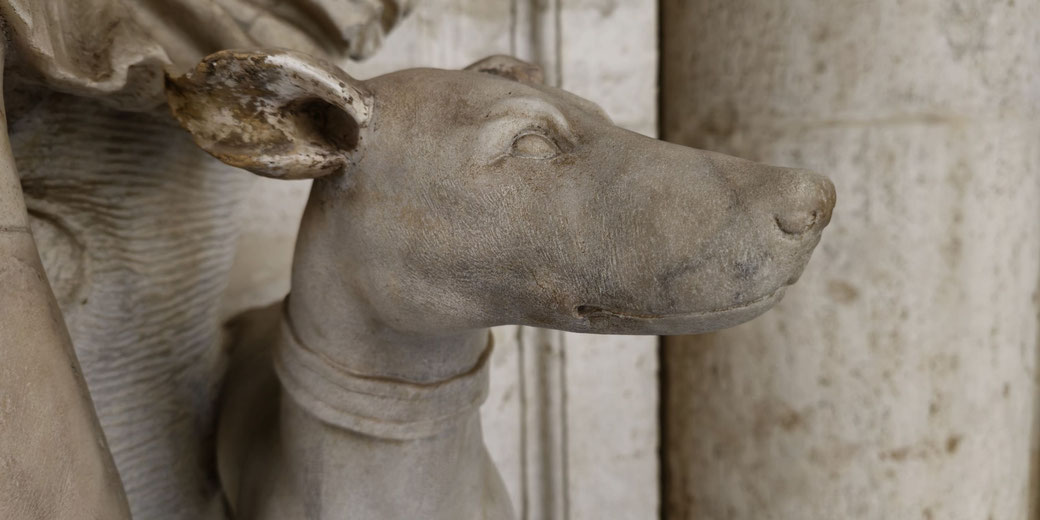The dog who was worshipped as a Catholic saint during the Middle Ages

In medieval France, a remarkable religious tradition emerged around a new and unusual saint. The Catholic Church began to hear stories of a sacred figure called Guinefort, who had an increasing number of loyal followers.
However, unlike other saints, this one was a greyhound dog. Reports claimed that thousands of peasants visited his shrine to ask for miracles.
This drew the attention of admirers and, eventually, those who wanted to stop the movement as soon as possible.
So, how did an animal become a well-known symbol of faith?
Who was Saint Guinefort?
In the 13th century, near the French village of Neuville-sur-Ain, a story began to spread that a local knight owned a greyhound named Guinefort.
One day, the knight left his baby son in the dog’s care while he went hunting.
When the knight returned, he found the nursery in a mess, the baby’s bed overturned, and no sign or sound of his son anywhere.
All he saw was the dog covered in blood. In a quick rage, the knight thought the dog had attacked, killed, and eaten his son, so he killed Guinefort immediately.
Only then did he hear the child crying from under the overturned crib. The knight looked closer and saw that the child was completely unharmed.
However, beside the crying baby was a dead snake, covered in dog-bite marks.
That is when he realised that Guinefort had actually saved his son’s life by killing the snake.
As a sign of regret for what he had done, the knight buried Guinefort in a well, covered it with stones, and planted trees nearby to honour his sacrifice.
Soon after, local villagers heard about the dog's brave act and started visiting the burial place to show their respect.
As the story spread, the visitors built a simple shrine.

The rapid popularity of Saint Guinefort
Soon, pilgrims began to say that their prayers had led to miraculous healing. The reports of healing often involved sicknesses such as fevers, infections, and unknown illnesses.
In one case, a child with a high fever reportedly got better after being taken to the shrine.
The child's parents believed that the healing came from Guinefort's help and told others about it.
It encouraged more people to pray for miracles and spiritual protection against danger, which was not surprising, since people believed that Guinefort had saintly powers.
Mothers brought their sick children to the site, and those who had been hurt in battle or accidents came too, all hoping for healing through the saint’s help.
The practice became especially popular among local peasants, who saw Guinefort as a special protector of the weak. To them, his story showed loyalty and bravery.
How the Church reacted
When news of the greyhound’s worship reached Church leaders, they were quickly concerned.
Stephen of Bourbon, who was a Dominican inquisitor, became particularly interested in the case.
He travelled to the site around 1261 to investigate the reports, and he found villagers carrying out rituals at Guinefort’s grave, leaving offerings, and holding ceremonies to ask for the dog's help.
Sometimes, they tied pieces of cloth to the trees around the shrine. Each piece represented a request for assistance.
For the Church, such behaviour threatened the seriousness of Christian worship; it mixed approved honouring of saints with banned folk beliefs.
In his report, Stephen criticised the cult as superstitious, claiming that the villagers’ faith in a dog weakened proper belief and took attention away from true Christian teachings.
The Church saw the cult of Saint Guinefort as too close to pagan animal worship.
This remained a problem in some rural areas, where older, non-Christian beliefs still affected religious habits.
To stop this forbidden activity, he ordered the shrine to be torn down and told the local priests to stop the cult.
The shrine was burned, along with the nearby trees, in an attempt to remove all signs of worship.
However, his efforts had little success, as the cult of Saint Guinefort lasted for many centuries. In fact, the last known pilgrim to visit the site was in the 1940s.
The story of Saint Guinefort was one of many medieval examples of unofficial "folk saints," figures not approved by the Church but honoured by local communities, who looked for help beyond official religious systems.
What do you need help with?
Download ready-to-use digital learning resources
Copyright © History Skills 2014-2025.
Contact via email
With the exception of links to external sites, some historical sources and extracts from specific publications, all content on this website is copyrighted by History Skills. This content may not be copied, republished or redistributed without written permission from the website creator. Please use the Contact page to obtain relevant permission.





